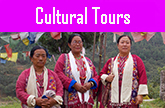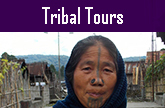Arunachal Pradesh Tribal Tour
Tour Duration : 11 Nights / 12 Days
Travel Season : September to May
arunachal pradesh tribal tour itinerary:
Day 01: Guwahati - Tezpur (166 kms, 4 hrs drive)
Meet upon arrival at Guwahati Airport / Railway Station.
Guwahati:
Guwahati, 'the city of Eastern light' stands on the southern bank of the mighty river Brahmaputra. It is the capital city of Assam and the gateway to the entire north-eastern states. Modern Guwahati is the hub city of Assam. It fulfills every aspect of a metropolitan city with its advanced means of transport, communication and media, as a major center of business activity, educational institutions, and various administrative and political activities of entire Assam. Besides, its landscape surrounded by hills and the mighty Brahmaputra River, rich and diverse flora and fauna enhances its natural scenic beauty.
If time permits, visit in Guwahati -
Kamakhya Temple:
Kamakhya Temple, one of the greatest 'Shaktipeeth', the shakti shrine of Goddess Kamakhya is situated on the Nilachal Hills. It is the oldest center of Tantric Shaktism. A famous legend regarding the birth of the Kamakhya temple narrates that Lord Shiva, rage with anger at his wife Sati's death, wandered the entire earth carrying Sati's corpse. An organ of Sati fell here and eventually the place became a temple of worship in due course of time. The temple features various stone inscriptions, terracotta works, sculptures and idols of Ganesha and Chamundeswari which are worth mentioning. The famous 'Ambubachi Fair' is celebrated with great enthusiasm every year in mid-June in this temple and devotees from different parts of India throng into it for the special occasion.
Srimanta Sankardev Kalakshetra:
Sankardev Kalakshetra is named after the most illustrious son and Vaishnavite propagator of Assam. It is the hub of all the cultural activities of entire Assam and a center for the promotion and preservation of the cultural heritage of the various tribes, communities and ethnic groups of Assam. It consists of a museum wherein lies the various traditional dresses, jewelry, ancient pottery, weapons belonging to various ethnic groups, sculpture, and works of art created by various artists depicting as a whole the entire Assam. The open air amphitheatre, wherein the cultural performances are held very often and the collection of whole life activities of the legendary artist Dr. Bhupen Hazarika carry a great measure in Kalakshetra.
Later, take transfer to Tezpur.
Tezpur:
Tezpur, the 'city of love' is situated on the northern bank of the Brahmaputra River. The ancient name of Tezpur was Sonitpur, the kingdom of the mighty legendary king, Baan Raja. It was the capital city under his reign. Tezpur holds in its heart many ancient historical events, and witnessed many legends and mythological wars of ancient Assam. The occurrence of a famous war named 'Hari-Hara' is related with the attainment of the present day Tezpur. This battle led to the bloodshed of so many soldiers that the entire place was stained with blood and hence the city came to be known as Tezpur ('Tez' meaning blood and 'pur' meaning city in Assamese language). Present day Tezpur was founded by the British colonial administration in 1835 as the headquarters of Darrang district.
Arrive at Tezpur, check-in at hotel. Later, visit at Tezpur -
Agnigarh:
Legend speaks of Agnigarh as a fortress built by Baan Raja in order to keep his daughter in isolation. The word 'Agnigarh' is a derivation of two Sanskrit words: 'Agni' meaning 'fire' and 'garh' meaning 'fort'. Situated on the north bank of the Brahmaputra River, it maintains its gracefulness with its lush green landscapes of the river. Nowadays, magnificent works of sculpture are depicted referring to the love story of Usha-Aniruddha and Great War 'Hari-Hara Juddha'.
Mahavoirab Temple:
Mahavoirab temple is the oldest Shiva shrine, where the second biggest Shiva linga of the world is worshipped. The temple was built by King Baan, the ruler of Sonitpur in 10th century. King Baan's daughter Princess Usha was a devotee of Lord Shiva and visited the temple for daily worship. Thousands of devotees gather during Shivaratri every year to offer prayers in this temple.
Evening: Free at leisure. Overnight: Stay in hotel.
Day 02: Tezpur - Itanagar (160 kms, 4 hrs drive)
In the morning after breakfast, take transfer to Itanagar. En-route visit -
Naagsankar Temple:
There are many beliefs prevailing regarding the history of Naagsankar temple, a famous Shiva shrine located near Chotia. According to mythology, the powerful King Naagmatta (another name Arimatta), believed to be the son of river God Brahmaputra built the Naagsankar temple. Another belief states that King Naagsankar of Lohitya dynasty who ruled ancient Assam in 378 A.D. built this temple around 4th A.D. The renovation of the temple took place under the reign of Ahom King Su-Seng-Pha in 1480. The main attraction of the temple is a large pond adjacent to it inhabited by a wide variety of rare species of turtles and local fishes. Some turtles are believed to be around 100 years old. Being a Shiva shrine, Shivaratri is celebrated with great pomp and joy in this temple.
If permission granted, visit -
Tea Factory:
Visit a bought-leaf tea factory and witness processing of globally acclaimed Assam tea.
Later, visit on the way -
Monabari Tea Estate:
Monabarie Tea Estate in Biswanath Chariali District of Assam is the World Biggest Tea Garden and Asia's Largest Tea Estate.The tea estate is owned by the McLeod Russel India Limited, a part of Williamson Magor Group.The Tea Garden Covers the Tea plantation area of 1158 hectares out of 1400 hectare of the total granted area. This tea garden produced 3150 tons crop per year. The Tea garden's workforce population is 2718.The Tea garden Manufactures 100% CTC Tea with 'Reddish Bright ' Quality. (Tip : Stop for a while and have some clicks posing in the tea plantations.)
Later, arrive at Itanagar and check-in at hotel.
Itanagar:
The historic capital city of Arunachal Pradesh, Itanagar stands on the dawn lit Himalayan foothills. A home to the Nyishi tribes, this town is located in the very midst of the state surrounded by traditional and modern wood-crafted tribal houses. Itanagar fascinates tourists to its rich archaeological and religious sites and its magnificent display of tribal arts, crafts and textiles.
In Itanagar, visit -
Ita Fort:
This ‘fort of bricks’ is located at the midst of the Itanagar town. The construction of this fort dates back to 1360 to 1550 A.D. during the rule of the Jitari dynasty. The structure of this fort is not regular in arrangement. This huge fort was built with more than 80lakhs of bricks and 45 centimeters of stone. The length of the complete brickwork of the fort is estimated to be about 16,200 cubic meters. It consists of three entrance gates on its eastern, western and southern sides.
Ganga Lake:
Locally named as ‘Gekar Sinyi’, this natural lake is a delightful spot for picnic and boating experiences. It surrounds an area about 4 sq. km. and is a home to a number of birds. Standing on the foothills of the Himalayan range, the lake is encompassed by forests full of bamboo and fern trees, orchids and different types of vegetation.
Evening: Free at relaxation. Overnight: Stay in hotel.
Day 03: Itanagar - Ziro (110 kms, 4 hrs drive)
In the morning after breakfast, visit in Itanagar -
Buddhist temple:
The Buddhist temple is set within the premises of magnificent gardens located atop on a hill. The yellow roof of the temple displays a Tibetan touch along with a stupa established in front of the shrine. A tree planted by Dalai Lama beside this beautiful temple reflects his holy presence over the entire place.
Jawaharlal Nehru State Museum:
The Jawaharlal Nehru State Museum reflects the rich tribal heritage of Arunachal Pradesh. It displays various handicrafts and archaeological remains, textiles, musical instruments, wood carvings, weapons of the past ages. It showcases a unique collection of ancient art and craft, jewellery, variety of tribal headgears etc. A library and a handicraft workshop centre dealing in traditional cane manufacture are also present here.
Later, drive to Ziro.
Ziro:
A remarkable plateau and the abode of the Apatani people, Ziro set at a high altitude is renowned for its pine and bamboo grooves, Tarin, the high altitude fish farm, exotic landscape with a delightful view of sunrise from the hilltops, tribal culture and a centre of crafts such as cane and bamboo products. It is a perfect spot for adventure enthusiasts, offering endless experience for trekkers and hikers.
Arrive at Ziro and check-in hotel.
Evening: Free at relaxation. Overnight: Stay in hotel.
Day 04: Ziro
In the morning after breakfast, visit at Ziro -
Apatani tribal villages:
Hong, Hari, Hija, Duta, Bula, Tajang, Bamin Michi and Mudang Tage are eight distinctive Apatani villages situated at Ziro valley. Visit Hong village, the largest village of Apatani plateau and other Apatani villages as well. There are more than 5,000 people living in 700 houses at Hong village. In every village, there are some male community halls called 'Lapang'. Apatani people are famous for tattoo on their forehead and nose plug. Basically, Apatani people are animist who worship all natural gods. Donyi-Polo, i.e, the Sun and Moon is their supreme God. Apatani people are known for paddy cum pisciculture. They celebrate Myoko festival in the month of March for the welfare of their community and Dree festival in July for bountiful harvest, community well being and to keep away the pest.
Shiva Lingam:
The calm hills of Kardo hold one of the largest Shivalinga with a height measuring 25 feet and 22 feet in circumference. The Shivalinga excavated in the recent past is located near Hapoli town.
District Museum:
The District Museum at Zero exhibits a variety of handicrafts and textiles, musical instruments, weapons of the past ages used by different tribes and sub-tribes of Arunachal Pradesh. It displays an exclusive collection of art and craft, jewellery, variety of tribal headgears etc reflecting the traditions of ancient tribal culture.
Craft Center:
Craft Center showcases the unique crafts and handloom products of the Apatani tribe. A wide selection of craftsmanship is displayed in carpet weaving (woolen carpets) and traditional cloths exhibiting a tribal influence.
Regional High Altitude Fish Seed Farm:
Regional High Altitude Fish Seed Farm located at Tarin is a unique reflection of paddy and fish cultivation practiced by the Apatani tribe. The cultivation is carried out encompassing an area of 200 kilometers in Kamala valley. Tourists flock in this high altitude farm to view the distinctive farming covered by pine and bamboo grooves.
Overnight: Stay in hotel.
Day 05: Ziro - Daporizo (170 kms, 6 hrs drive)
In the early morning after breakfast, take transfer to Daporizo. En-route visit -
Nyishi tribal village:
The main community of Raka village is Nyishi tribal people. Nyishi people are also called as 'Nyashang' meaning people of the land. Folk tales and oral literature narrates the Nyishis to be the migrants from Tang Sampo valley of Tibet. Abotani was the earliest ancestor of this tribe. The source of livelihood of this tribe is agriculture, mainly Jhum cultivation. Initially, polygamy was practiced by the Nyishi people, but it is less observed in recent times. The Nyishis celebrate 'Nyokum', a festival honouring their ancestors.
Hill Miri tribal village:
The inhabitants of both Raga and Dokum villages are Hill Miri tribes - one of the sub tribe of Nyishi people. Claiming to be the descendents of Abotani, Hill Miri tribe is believed to be the migrants of Ane Saingik Nite. They comprise a small population of less than 10,000 people in this planet. Hill Miri people are good hunters. They speak the Hill Miri language or sarak, which is a form of Tibetan-Burman language family.
Later,drive to Daporizo.
Daporizo:
Located on the right bank of the Subansiri River, Daporizo is a small town set along remarkable villages and beautiful caves. The residing population here speaks languages such as Tagin, Hill Miri, Adi, Assamese, Hindi and English. Suspension bridges carved out of bamboo and cane over the Subansiri River are great attraction to tourists. Daporizo is also famous for its picnic spot.
Arrive at Daporizo and check-in tourist lodge / hotel.
Later, visit -
Tagin tribal village:
The inhabitants of Ligu village are Tagin and Hill Miri tribal people. Tagin tribe is regarded to be the migrants of Penji, a village in Tibet. They are believed to be the descendants of Abotani. The Tagins are the supporters of Donyi-Polo, whereas the Naa and Mra (two groups of Tagin) are strong followers of Tibetan Buddhism. Si-Donyi is an important festival of this tribe celebrated to honour the Earth and the Sun.
Overnight: Stay in tourist lodge / hotel.
Day 06: Daporizo - Along (160 kms, 6 hrs drive)
In the morning after breakfast, visit at Daporijo -
Tagin tribal village:
Shikarizo, one beautiful village in Daporizo is resided by only Tagin tribal people. Tagin tribe is regarded to be the migrants of Penji, a village in Tibet. They are believed to be the descendants of Abotani. The Tagins are the supporters of Donyi-Polo, whereas the Naa and Mra (two groups of Tagin) are strong followers of Tibetan Buddhism. Si-Donyi is an important festival of this tribe celebrated to honour the Earth and the Sun.
Menga Cave:
Menga cave is a magnificent natural cave honoured to Lord Shiva. Visitors are attracted in large numbers to this popular place of worship. Devotees gather in large numbers during Makar Sankranti and Shivaratri festivals.
Then take transfer to Along. En-route visit -
Galong tribal village:
Bararupak village is inhabited by Galong tribe. One of the most populous tribe of the state, the Galong tribe reside in West Siang, south western side of East Siang, south eastern side of Upper Subansiri and in some small areas in Lower Dibang Valley and Changlang districts of Arunachal Pradesh. Both monogamy and polygamy is prevalent in this tribe following a patriarchal system of society. The base of economy of this tribe is agriculture. Initially, shifting cultivation was practiced by Galong people, but at present Wet Rice and terrace cultivation dominates the agricultural scenario. Although Galong is spoken by 95% of the population, people also speak Assamese, Hindi and English language.
Later, drive to Along.
Along:
Set on the south bank of river Siyom at an altitude of 300 meter above sea level, Along (locally called as Aalo) small town, covered with scenic natural surroundings, serves as a suitable site for holidaying during the summer months and adventure sports like trekking, hiking and angling as well.
Arrive at Along and check-in hotel.
Evening: Free at relaxation. Overnight: Stay in hotel.
Day 07: Along
In the morning after breakfast, take a full day excursion of Along visiting -
Donyi-Polo Temple:
Established in 1972, Donyi-Polo temple at Along is a religious center of the followers of Donyi-Polo religion. Out of 400 community centers in Arunachal Pradesh, it is designated to be the only worshipping centre of Donyi-Polo religion in the entire state. The religion possesses no written scriptures. The rituals and traditions have been orally passed from ancestors to the next generations. There is a belief among Donyi-Polo animists of a common lineage of all the people of Arunachal Pradesh as the descendants of Abotani. The rituals of this religion include invoking of the spirit and nature along with holy sacrifices to the spirits. The Donyi-Polo temple acts as a centre of worshipping objects of nature, the Sun and the Moon. The temple premises consist of a community hall, a meditation room and a prayer hall.
Galong tribal villages:
The inhabitants of Kabu, Pobdi and Paya villages are Galong tribal people. Both monogamy and polygamy is prevalent in this tribe following a patriarchal system of society. The base of economy of this tribe is agriculture. Initially, shifting cultivation was practised by Galong people, but at present wet rice and terrace cultivation dominates the agricultural scenario. Even though Galong language is spoken by 95% of their total population, people also speak Assamese, Hindi and English language.
Suspension Bridge:
The Suspension Bridge on the Siang River is another tourist attraction worth watching. It is made of local cane and bamboo which exhibits superb skills of the local tribal people. The bridge is approximately 60 to 70 meters long, connecting to the other hill tribes of nearby areas. Fishing in Siang river near the bridge is a favourite pastime of the locals.
Ramkrishna Mission:
The joint efforts and initiative of Govt. of India and the mission authorities at Belur Math led to the establishment of a school at Along in 1966. Started with an enrolment of only 35 students in a thatched building, the school gradually introduced in its curriculum vocational courses on tailoring, carpentry, industrial workshop, computer training etc. It also opened up a printing press and included accessories such as dairy farm, poultry farm and an agricultural field within the school campus. The school, providing co-education has increased its student population to a number of 2241 with a hostel facility of 260 tribal boys only. Apart from providing formal education and academic excellence among the students, the mission aims at the overall development of the students including moral education, health education, vocational training to prepare them for self sufficiency in their future lives.
Later, visit the local market at Along.
Evening: Enjoy a cultural show of Erap dance (warrior dance of Galong tribe) or Ponu dance (of Galong tribe) or Tapi dance (of Adi- Minyong tribe) along with an ethnic feast. (Optional)
Overnight: Stay in hotel.
Day 08: Along - Pasighat (130 kms, 6 hrs drive)
In the morning after breakfast, take transfer to Pasighat. En-route visit -
Confluence of Siang and Siyom:
Have a look into the scenic beauty of confluence of two rivers - Siang and Siyom. The source of Siang River is Talung Tso Lake in south-western part of Tibet. This trans-boundary river is named as Yarlung Tsangpo in Tibet, Siang in Arunachal Pradesh, Brahmaputra in Assam and Jamuna in Bangladesh.
Komsing:
Drive further to visit -
Adi Minyong tribal village:
The inhabitants of Pangin village are Adi Minyong tribal people. Minyong, Padam and Passi are the sub tribes of Adi. They practice both terrace farming and shifting cultivation. Solung is the main festival of Adi tribe celebrated during the 1st week of September every year. Adi people have a community hall called Dere where children of different age group gather to learn about social norms from elderly citizens.
Kekar Monying:
Later drive to Pasighat.
Pasighat:
One of the oldest towns of Arunachal Pradesh and the homeland of the Adi tribe, Pasighat, set on the bank of river Siang is surrounded by snow-covered peaks and rocky mountain. It supports a wild variety of flora and fauna. Adventure sports like trekking and hiking, river rafting, boating and angling on the Siang river call for an exciting trip to this place.
Arrive at Pasighat and check-in hotel. Overnight: Stay in hotel.
Day 09: Pasighat
In the morning after breakfast, take an excursion to Adi Padam and Idu Mishmi tribal villages.
Adi Padam tribal village:
The inhabitants of Mebo village are Adi Padam tribal people. Padam, Passi and Minyong are the sub tribes of Adi tribe.
Idu Mishmi tribal village:
The inhabitants of Aohali village are Adi Padam tribal people.
Later, return to Pasighat. Overnight: Stay in hotel.
Day 10: Pasighat - Dibrugarh (150 kms, 3 hrs drive)
In the morning after breakfast, take transfer to Dibrugarh. En-route cross - the mighty Brahmaputra River through newly built Bogibeel bridge.
Dibrugarh:
The 'Tea City of India', Dibrugarh is located in the eastern part of Assam. It is situated on the banks of the river Brahmaputra in upper Assam. Main attraction is mainly tea gardens along with oil and natural gas reserves. There are more than 165 tea gardens in and around Dibrugarh district. The foothills region of Dibrugarh is composed of lateritic soils, which is suitable for the production of tea plants. Besides, Dibrugarh city is the main educational centre of Upper Assam with important educational institutions like Dibrugarh University, Assam Medical College, Kanoi College, Salt Brook Academy etc.
Arrive at Dibrugarh and check-in hotel.
If time permits, visit -
Haaj-Paar:
It is a small weaving centre located at Chiring Chapori, an urban locality of Dibrugarh. Here traditional mekhela chadars are woven in variety of designs by employed women and is run privately. They also weave sarees from both 'muga' and 'paat' silk unique to Assam. The products made in the centre are available for sale.
Evening: Free at leisure to visit local market at Dibrugarh town. Overnight: Stay in hotel.
Day 11: Dibrugarh - Namphake Village - Dibrugarh (40 kms one way)
In the morning after early breakfast, take transfer to Namphake Village.
Namphake Village:
The Phakial community of Assam established Namphake village in 1850 AD. Presently, the village is inhabited by 600 members of the community. The word ‘Phake’, connected with Tai community, is a combination of two Tai words ie, ‘Pha’ and ‘ke’ meaning ‘wall’ and ‘ancient’ respectively. Historically, natives in Myanmar dwelling near ancient stone walls were recognized as ‘kunphake’ meaning “people inhabiting near phake part of the country”. The present inhabitants of Namphake village are considered to be the descendants of those ‘phake’ people of Myanmar. The Tai race, a large section of nomadic Mongolian association, currently inhabits in entire Asia. In Myanmar, Thailand and Yunnan province of China, they are recognized as the Shan, Siamese and Pai respectively. In countries like Cambodia, Laos and Vietnam, they are familiar as the Lao population. Tai Phake people in Assam are popularly known as ‘Phakial’. Many noted historians of Assam opine that the Phakials are immediate descendants of the mighty Ahoms. Phakial people established some other villages like Borphake, Tipamphake in the districts located in upper Assam. Yet the largest village among all is the Namphake village near Naharkatiya. In spite of being fused into greater Assamese culture, the Phakial community has been conserving its own distinctive culture and age old traditions and thereby contributing to the rich Assamese culture. Followers of Buddhism, the Phakials in Namphake village are maintaining a Buddhist monastery with several astounding monuments within its premises. Moreover, a Buddhist Pagoda and a symbolic Ashoka pillar in the monastery premises are worth seeing.
Later, return to Dibrugarh. Visit a Sonowal Kachari Village like Hatimora, Bogpara, Chaulkhowa, Niz Mankotta, Tepor Gaon, Boiragimath.
Sonowal Kachari village:
Designated to be the scheduled Bodo tribal community, Sonowal Kacharis form the third largest tribal group (plains) of Assam. They are primarily found in the districts of Dibrugarh, Tinsukia, Jorhat, Golaghat, Sivasagar, Lakhimpur and Dhemaji. It has been very difficult to trace the origin of Sonowal Kacharis over the years. It is popularly believed that a few population of the Kachari tribal community were occupied in cleaning gold elements from the sands of river during the reign of the Ahom rulers. Thus, the prefix 'Sonowal' meaning ‘gold washer’ was added before their main tribal identity ‘kachari’ to indicate their particular population. A famous anecdote recommends that during the rule of Ahom king Godadhar Singha, a 'Gossian' (meaning a priest) named 'Kechaideo' had mystical powers of contributimg a definite quantity of gold in a bamboo tube. After becoming followers of 'Kechaideo', these people became popular as Sonowal Kacharis.
Sonowal Kacharis have 7 exogamous clans namely Chiripuria, Balikhitiari, Ujani-Kuchiya, Amarabamiya, Tipamiya, Dhulial and Namoni-Kuchiya. Yet again, these clans are sub grouped into 14 sub-clans namely Muktal, Hagral, Borttajoal, Madan, Ahmal, Manikiyal, Dhekial, Formal, Oingial, Saru Hazowal,Dangral, Kumral, Chetial and Lothial. Sonowal Kacharis are dedicated followers of Vaishnavism. Some prominent songs of Sonowal Kacharis are Husori, Haidang, Biya naam, Aai naam, Gossain Naam, Dhai naam, Apeswara Naam and Lakhimi naam. Some amazing traditional dance forms in addition to Bihu are Bohuwa dance, Kula-burhir dance and Hugra dance.
The Sonowal Kacharis presently do not have any particular dialect of their own. They commonly speak Assamese language. During Ahom rule, the Sonowal Kacharis in their course of integration with the non tribal communities adopted non tribal surnames like Bora, Saikia, Hazarika etc. Agriculture and poultry farming of rearing hens, ducks & cattle are the major occupations of Sonowal Kacharis. Drinking of Rice Beer is a popular habit among masses. Weaving at traditional ordinary weaving machines at home to produce items like endi chadar (silk cloth) and gamocha is a customary activity among women.
Overnight: Stay in hotel.
Day 12: Dibrugarh departure
In the morning after breakfast, take transfer to Dibrugarh Airport / Railway Station for your onward destination.
Tour terminates here
North East India Tourism
Package Inclusions:
# All ground transportation by a comfortable vehicle driven by dedicated driver
Package Exclusions:
# Any air fare or train fare


















